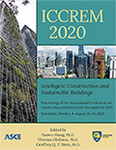International Conference on Construction and Real Estate Management 2020
Automation in Extraction and Sharing Information between BIM and Project Management Databases
Publication: ICCREM 2020: Intelligent Construction and Sustainable Buildings
ABSTRACT
Adopting building information modeling (BIM) has drastically improved industrial construction processes (e.g., productivity, safety, and quality). Due to intellectual property rights, fast-track processes, and software application compatibility, however, information flow from/to BIM is limited. To increase BIM utilization, the proposed framework incorporates a dynamic data adaptor, structured query language (SQL) functions, and the longest common substring algorithm. With the data adapter, information (including BIM) stored in separated databases can be effectively extracted in real time. The dynamic programming (DP)-based longest common substring algorithm automates information mapping based on auto-detected keywords. Lastly, SQL functions aggregate the desired information from different data sources. A case study of an oil and gas project from Alberta, Canada, demonstrates the capability and applicability of the proposed framework. With the proposed methodology, any commercial or in-house developed project-management database can link to BIM in real time. This research enhances information flow between various database types.
Get full access to this article
View all available purchase options and get full access to this chapter.
ACKNOWLEDGMENTS
This project was supported by a Collaborative Research and Development Grant (CRDPJ 492657) from the Natural Sciences and Engineering Council of Canada.
REFERENCES
Ali, M. and Mohamed, Y. (2017). “A method for clustering unlabeled BIM objects using entropy and TF-IDF with RDF encoding.” Advanced Engineering Informatics, 33(1), 154-163.
Bellman, R. (1954). “The theory of dynamic programming.” Bulletin of the American Mathematical Society, 60(6), 503-515.
Davies, K., McMeel, D.J. and Wilkinson, S. (2017). “Making friends with Frankenstein: hybrid practice in BIM.” Engineering, construction and architectural management, 24(1), 78-93.
Eastman, C., Lee, J.M., Jeong, Y.S. and Lee, J.K. (2009). “Automatic rule-based checking of building designs.” Automation in construction, 18(8), 1011-1033.
Gusfield, D. (1997). Algorithms on strings, trees, and sequences: computer science and computational biology, Cambridge university press, Cambridge.
Hornik, K. (2018). “R FAQ: frequently asked questions on R” https://cran.r-project.org/doc/manuals/r-release/R-FAQ.html (Otc. 18, 2018).
Nath, D., Kurmi, J. and Rawat, V. (2018). “A survey on longest common subsequence.” International Journal for Research in Applied Science Engineering Technology, 6(4), 4553-4557.
R Core Team (2014). “R: a language and environment for statistical computing.” https://www.R-project.org/ (Oct. 26, 2014).
Ripley, B. and Lapsley, M. (2019). “RODBC database interface.” https://cran.r-project.org/web/packages/RODBC/RODBC.pdf (Sep. 3, 2019).
Solihin, W., Dimyadi, J., Lee, Y.C., Eastman, C. and Amor, R. (2017). “The critical role of the accessible data for BIM based automated rule checking system.” Proceedings of the Joint Conference on Computing in Construction, (1), 53-60.
Solihin, W. and Eastman, C. (2015). “Classification of rules for automated BIM rule checking development.” Automation in construction, 53(1), 69-82.
Wickham, H., Francois, R., Henry, L. and Muller, K. (2019). “A grammar of data maniqulation.” http://dplyr.tidyverse.org (Sep. 7, 2019).
Zhou, Y.W., Hu, Z.Z., Lin, J.R. and Zhang, J.P. (2019). “A review on 3D spatial data analytics for building information models.” Archives of Computational Methods in Engineering, (2019), 1-15.
Information & Authors
Information
Published In
ICCREM 2020: Intelligent Construction and Sustainable Buildings
Pages: 37 - 46
Editors: Yaowu Wang, Ph.D., Harbin Institute of Technology, Thomas Olofsson, Ph.D., Luleå University of Technology, and Geoffrey Q. P. Shen, Ph.D., Hong Kong Polytechnic University
ISBN (Online): 978-0-7844-8323-7
Copyright
© 2020 American Society of Civil Engineers.
History
Published online: Oct 14, 2020
Authors
Metrics & Citations
Metrics
Citations
Download citation
If you have the appropriate software installed, you can download article citation data to the citation manager of your choice. Simply select your manager software from the list below and click Download.
